|
|

Reflections & Reports from IARPP 2012 Conference
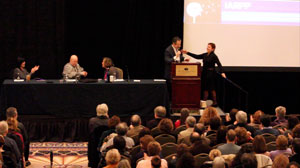 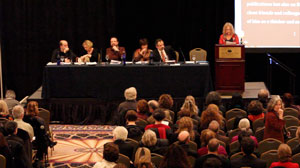
IARPP President Spyros Orfanos introduces President-Elect Susanna Federici - Margaret Black opens the Conference
|
Always on Sunday
Presidential Musing on our 10th Annual Conference NYC
by Spyros Orfanos
NYC USA
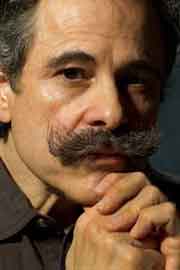 It was always on Sunday afternoon. There was brandy on the table along with unshelled almonds and walnuts. The immigrant men, tired from the week’s hard labor, would take off their shoes. My uncles, Vasilis and Spiros, would motion me to join the circle. Together we told each other stories. The men often spoke about the oppressive factories and basement bakeries, and recalled the devastating poverty of the country they left behind. My stories were about the ancient myths I learned in school that week. Religion and science had not yet taken over my imagination. The conversation would sometimes turn melodramatic and I would feel scared. Surrounding and serving us without drama were the women. I would feel safe when they were around. They were always dressed in black, mourning some long lost relative. The afternoon’s end meant that I had to get ready for school the next day and leave these amazing people. We would all go to our respective homes and begin anew. I felt sad. It was always on Sunday afternoon. There was brandy on the table along with unshelled almonds and walnuts. The immigrant men, tired from the week’s hard labor, would take off their shoes. My uncles, Vasilis and Spiros, would motion me to join the circle. Together we told each other stories. The men often spoke about the oppressive factories and basement bakeries, and recalled the devastating poverty of the country they left behind. My stories were about the ancient myths I learned in school that week. Religion and science had not yet taken over my imagination. The conversation would sometimes turn melodramatic and I would feel scared. Surrounding and serving us without drama were the women. I would feel safe when they were around. They were always dressed in black, mourning some long lost relative. The afternoon’s end meant that I had to get ready for school the next day and leave these amazing people. We would all go to our respective homes and begin anew. I felt sad.
About 55 years later, I am sitting with a group of women in the lobby restaurant of the Roosevelt Hotel. It is Sunday afternoon immediately after the close of IARPP’s 10th anniversary conference in New York City. Pinot Grigio wine and green salads rest on the table. We are eating feverishly. Immigrant waiters with heavy Pakistani accents are dressed in black uniforms and serve us unobtrusively. The conference duo chairs, Margaret Black and Hazel Ipp, having taken off their heels hold my attention with stories about all that has taken place since the opening of the conference on Thursday. They laugh hard and marvel at having devised and implemented a first-rate meeting that contained multitudes. Hazel credits Margaret and Margaret credits Hazel. We had close to 700 people from 22 countries come to the meeting. They were a rich combination of committed relationalists and those curious about the relational perspective. And, they were pleased because, as promised, Margaret and Hazel helped us celebrate the legacy of Stephen Mitchell. Participants demonstrated in unique ways how they sustain creativity in psychoanalytic work. The ideas, the conversations and the human connections combined to become greater than the sum of their parts.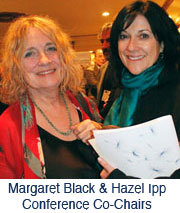
Those conference attendees not in a rush to get to the airport stopped by to thank the co-chairs for the job they had done. As they had throughout the four day gathering, Margaret and Hazel were gracious about it all, thanking the registrants and adding that it took first-rate presenters/faculty and a smart audience to make the conference successful. Ramon Riera from Barcelona gave huge hugs and Estelle Shane from Los Angeles added more. Gianni Nebiossi from Rome, triumphant from his plenary presentation a few hours earlier, was enjoying a few well-deserved moments of repose. Young Anna Bezevegki from Athens was delighted with having just discovered relational studies. Maria Eugenia Boetsch from Santiago radiated an infectious smile as she explained that next year’s November conference in Chile had a hard act to follow.
All good things come to an end and I too felt sad on this Sunday afternoon. How could I not be sad with the ending of an experience Susi Federici, president-elect, called “magic” and Sharon Ziv Beiman, Board member, called “truly amazing!”? Maybe it was also the awareness that on Monday morning I would again enter the clinical arena - perhaps wiser because of the conference but also a bit tired. I imagine that most who attended the conference also felt something similar. In the final analysis, however, I was sad because I was saying good-bye to all the unique individuals with their special voices and complex repertoires. They gave me a deep and vital experience.
At the first IARPP conference ten years earlier in New York, Mannie Ghent, a prescient founder, said that the idea and hope was that IARPP would help us have “a new appreciation for the complexity and compass of the relational and the vistas it offers.” He was right. Who would have thought 10 years ago when we first created IARPP that the legacy would last and thrive? Who indeed?
|
|
Reflection on the March 2012 Conference
by Federico Pereira
Lisbon, Portugal
para a versão em Português, clique aqui
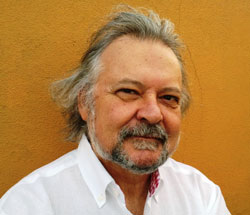 Everything revolves around origins but Stephen Mitchell was not a mythic larger-than-life founding father - he was simultaneously more and less than that. A real person, deeply curious and questioning about the Other and the Other’s thoughts, feelings, stories: “What do you think about it?” he asked, more interested in asking than in giving closed answers. Everything revolves around origins but Stephen Mitchell was not a mythic larger-than-life founding father - he was simultaneously more and less than that. A real person, deeply curious and questioning about the Other and the Other’s thoughts, feelings, stories: “What do you think about it?” he asked, more interested in asking than in giving closed answers.
An open mind, a creative mind, Stephen Mitchell, encyclopedic and modest, developed, I think, not only an open knowledge, but also a “style”. And if “le style c’est l’homme”, Stephen Mitchell’s style was in line with his way of being human, with his peculiar way of answering the fundamental ontic issue: “What is it like to be a human being?”
The conference, in several perspectives, reflected this style, this modesty, this humility in the face of suffering, this compassion. Steve conveyed to everyone a special sensibility to the nuclear problematic of human relationship and to the very idea of a Psychoanalysis as a special kind of human relationship, as symmetrical as possible, and marked by reciprocity, respect, responsibility and recognition in a dialectic tension with negation and rupture.
This complex attitude was reflected, so to say, in the ambience of the conference.
It was a great conference, not only regarding its scientific, philosophical and clinical issues, but also regarding the above mentioned dimensions.
A formal thought (but as informal as possible) updating an open mind beyond every dogmatism – which means the “death” of Psychoanalysis – the use of disclosure as an aspect of therapeutic relations, the presence of a dynamic relativism, perspectivism and constructivism point of view were some main issues in the conference, conducted in good homology with relational ideas and models.
Different from many other conferences, the IARPP Conference was also a rich and polymorphic human experience – not only a strong moment of knowledge building and sharing.
Last but not least, for us in Portugal, the formal acceptance of the Portuguese IARPP chapter has been a very important issue that happened in a nice informal and creative meeting of the representatives of all IARPP chapters from many countries.
The next conference will happen in Chile and I intend to be there, renewing relationships with paths opened by all those thinkers who have been and are the main creative minds in Contemporary Psychoanalysis.
Frederico Pereira
Training Analyst, Lisbon Portugal
l.frederico.pereira@gmail.com
|
|
“How Stephen Mitchell’s Writings
Influenced My Work as an Immigrant Analyst”
Summary of a Paper Presented at IARPP’s New York March 2012 Conference
by Ruth Lijtmaer
para la versión en español, haga clic aquí
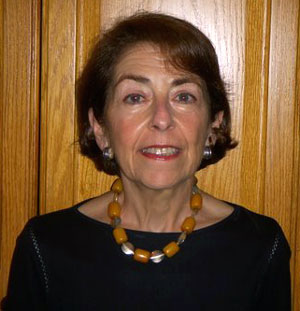 What follows are the basic concepts that I presented at the IARPP meeting in March 2012. In the presentation I described my personal experience as a bilingual immigrant analyst and showed how relational psychoanalysis helped me evolve in my work. I based my talk on the topics of: 1) Self-disclosure and Neutrality; 2) Boundaries; What follows are the basic concepts that I presented at the IARPP meeting in March 2012. In the presentation I described my personal experience as a bilingual immigrant analyst and showed how relational psychoanalysis helped me evolve in my work. I based my talk on the topics of: 1) Self-disclosure and Neutrality; 2) Boundaries;
3) Transference and Countertransfernce and 4) Language and Bilingualism.
1) One of the struggles for me, having been trained in the classical framework, is self-disclosure. How can I be “neutral” when as soon as I speak my patients know that I am a foreigner? How did my American, Hispanic and other foreign patients respond to this aspect of myself?
2) Boundaries: The bilingual/bicultural dyad enters into the therapeutic relationship that is bound by professionalism. However, the professional boundaries are more fluid in many Latin American countries than in the United States. As a result, the transference for bilinguals often depicts the therapist not as a professional but more like one's family. This creates a whole set of transferences that have to be dealt with. How did I handle them?
3) While transference may have intrapsychic origins in the form of internalized self-object relations, it is also a manifestation of a patient's socio-cultural roots and family-of-origin's cultural heritage. The analyst is not free from those influences. The term, "the clinician's cultural countertransference," refers to the clinician’s cognitively based American life values and theoretical beliefs, as well as the more subjectively charged personal biases about different ethnic groups. This state in the therapist holds significant potential for enactment within the treatment and can create impasses in our work.
4) Following the concept of “dual sense of self” (Marcos et. al., 1977) bilingual individuals experience themselves with a different sense of self depending on which language they communicate with others. For these individuals, each language is unique in evoking the relational experiences and social-contextual environment at the time of its initial acquisition and early usage. Paralleling the dynamics of their bilingual patients, bilingual clinicians can likewise construct formidable language-related transferences to their patients.
As a bilingual Spanish-speaking immigrant analyst, I work with bilingual patients. When these patients switch languages during the treatment process, I question: What happened to them? But also what happened to me? How has my bilingual/bicultural self affected my internal self-talk, fantasy and dreams and my responses to the patients?
Throughout my presentation I explored these questions and used clinical examples.
For copies of the full article please contact: ruth.lijtmaer@verizon.net
|
NOVA IORQUE. 1 A 4 DE MARÇO DE 2012
10º CONGRESSO DA IARPP.
TEMA CENTRAL: “O LEGADO DE STEP HEN MITCHELL -
MANTENDO A CRIATIVIDADE NO NOSSO TRABALHO PSICANALÍTICO”
by Federico Pereira
Lisbon, Portugal
for the enlish verison click here
 Tudo de certo modo tinha a marca das origens: Stephen Mitchell não foi um urvater: foi simultaneamente mais e menos do que isso. Uma pessoa real, profundamente curiosa e interrogativa acerca do Outro e das suas emoções, pensamentos, estórias: “o que pensa sobre isto?”, perguntava, mais interessado no questionar do que em respostas fechadas. Tudo de certo modo tinha a marca das origens: Stephen Mitchell não foi um urvater: foi simultaneamente mais e menos do que isso. Uma pessoa real, profundamente curiosa e interrogativa acerca do Outro e das suas emoções, pensamentos, estórias: “o que pensa sobre isto?”, perguntava, mais interessado no questionar do que em respostas fechadas.
Uma mente aberta, uma mente criativa, Stephen Mitchell, enciclopédico e modesto, desenvolveu, penso, não só um conhecimento aberto mas também um “estilo”. E se “le style c´est l´homme”, o “estilo” de Stephen Mitchell estava em conformidade com a sua forma de ser humano, com a sua maneira peculiar de responder à questão ontica fundamental: “Como é isso de ser um ser humano?”
O congresso, de diversas formas, reflectiu este estilo, esta modéstia, esta humildade em face do sofrimento, esta com-paixão. Steve trouxe a cada um a sua sensibilidade especial à problemática da Relação Humana, e à ideia de que a Psicanálise é uma forma singular da relação humana, tão simétrica quanto possível e marcada pela reciprocidade, pelo respeito, pela responsabilidade e pelo reconhecimento em tensão dialéctica com a negação e a ruptura.
Esta atitude complexa reflectiu-se, por assim dizer, também, no ambiente do congresso.
Um excelente congresso, não só no que respeita às suas dimensões científicas, filosóficas e clínicas, mas também no que respeita às dimensões acima referidas.
Um pensamento rigoroso e formal – mas tão informal quanto possível - actualizando uma mente aberta, para além de qualquer dogmatismo – que representa a morte da Psicanálise; a utilização da “disclosure” como aspecto das relações terapêuticas; a presença de uma relativismo, perspectivismo e constructivismo dinâmicos foram permanentes aspectos deste Congresso, conduzido de forma homóloga às ideias e modelos relacionais.
Diferente de muitos congressos o Congresso da IARPP traduziu-se ainda por uma experiência humana rica e polimorfa, para além de ter sido um momento forte na construção e partilha de saberes.
Por fim, não posso deixar de assinalar com grande satisfação que ele foi também a ocasião da formalização da Secção Portuguesa da IARPP, num encontro agradável e simpático com representantes das secções de muitos outros países.
O próximo congresso acontecerá no Chile, e lá estarei de novo, renovando laços com os caminhos abertos por todos os pensadores que foram e são as mentes criativas principais da Psicanálise Contemporânea.
Frederico Pereira
Psicanalista Didacta, Lisboa Portugal
l.frederico.pereira@gmail.com

"Cómo las escrituras de Stephen Mitchell influenciaron
mi trabajo como analista inmigrante"
por Ruth Lijtmaer
for the enlish verison click here
 A continuación transmito los conceptos básicos que presenté en la conferencia de IARPP en Marzo de 2012. En la presentación describí mi experiencia personal como analista inmigrante bilingüe y demostré cómo el psicoanálisis relacional me ayudó a desarrollarme en mi trabajo. Basé mi charla en los siguientes temas: 1) Revelación personal y neutralidad; 2) Límites; 3) Transferencia y contratransferencia y) bilingüismo. A continuación transmito los conceptos básicos que presenté en la conferencia de IARPP en Marzo de 2012. En la presentación describí mi experiencia personal como analista inmigrante bilingüe y demostré cómo el psicoanálisis relacional me ayudó a desarrollarme en mi trabajo. Basé mi charla en los siguientes temas: 1) Revelación personal y neutralidad; 2) Límites; 3) Transferencia y contratransferencia y) bilingüismo.
1) Una de los conflictos que enfrente se debió a mi entrenamiento que fue en la teoría clásica.¿Cómo puedo ser neutral cuándo tan pronto hablo mis pacientes saben que soy una extranjera? ¿Cómo mis pacientes americanos, el hispánicos y otros pacientes extranjeros responden a este aspecto de mi persona?
2) Límites. La pareja bilingüe/bicultural entra en la relación terapéutica que esta limitada por el profesionalismo. El límite profesional, sin embargo, es más fluido en muchos países latinoamericanos que en los Estados Unidos. Consecuentemente, la transferencia para los pacientes bilingües representa al terapeuta no como un profesional sino más bien como un familiar. Esto crea transferencias que tienen que ser tratadas. ¿Cómo las manejé?
3) Mientras que transferencia puede tener orígenes intrapsíquicos en la forma de relaciones internalizadas, es también una manifestación del patrimonio socio-cultural de la cultura en que vive el paciente como también en las raíces de la familia de origen del paciente. El analista no está libre de estas influencias. El concepto “contratransferencia cultural” se refiere a los valores cognitivos basados de la vida americana y en la creencia teórica del terapeuta como también a los prejuicios sobre diversos grupos étnicos. Este estado emocional del terapeuta tiene el potencial de influenciar que el trapista actúe en forma negativa y puede crear callejones sin salida en nuestro trabajo.
4) Las personas bilingües tienen un diverso sentido de si mismos dependiendo de qué lengua se comunican con otras personas. Para estos individuos, cada lengua es única en la evocación de las experiencias relacionales y del ambiente social del contexto en el momento su adquisición inicial y uso temprano. Esta dinámica de pacientes bilingües, es paralela a los clínicos bilingües que pueden construir semejantes transferencias a sus pacientes.
Como analista inmigrante de habla hispana bilingüe, trabajo también con los pacientes bilingües. Cuando estos pacientes cambian idiomas durante el proceso del tratamiento, pregunto: ¿Por que sucedió eso? Pero también ¿Qué me sucedió a mi?, ¿Cómo mi identidad bilingüe/bicultural ha afectado mi estado emocional interno, mi fantasía, mis sueños y mis respuestas a los pacientes?
A través de mi presentación exploré estas preguntas y utilicé ejemplos clínicos.
:For copies of the full article please contact: ruth.lijtmaer@verizon.net
|
Take me to eNews Cover | Take me to top of this page
|
|




 It was always on Sunday afternoon. There was brandy on the table along with unshelled almonds and walnuts. The immigrant men, tired from the week’s hard labor, would take off their shoes. My uncles, Vasilis and Spiros, would motion me to join the circle. Together we told each other stories. The men often spoke about the oppressive factories and basement bakeries, and recalled the devastating poverty of the country they left behind. My stories were about the ancient myths I learned in school that week. Religion and science had not yet taken over my imagination. The conversation would sometimes turn melodramatic and I would feel scared. Surrounding and serving us without drama were the women. I would feel safe when they were around. They were always dressed in black, mourning some long lost relative. The afternoon’s end meant that I had to get ready for school the next day and leave these amazing people. We would all go to our respective homes and begin anew. I felt sad.
It was always on Sunday afternoon. There was brandy on the table along with unshelled almonds and walnuts. The immigrant men, tired from the week’s hard labor, would take off their shoes. My uncles, Vasilis and Spiros, would motion me to join the circle. Together we told each other stories. The men often spoke about the oppressive factories and basement bakeries, and recalled the devastating poverty of the country they left behind. My stories were about the ancient myths I learned in school that week. Religion and science had not yet taken over my imagination. The conversation would sometimes turn melodramatic and I would feel scared. Surrounding and serving us without drama were the women. I would feel safe when they were around. They were always dressed in black, mourning some long lost relative. The afternoon’s end meant that I had to get ready for school the next day and leave these amazing people. We would all go to our respective homes and begin anew. I felt sad.
 Everything revolves around origins but Stephen Mitchell was not a mythic larger-than-life founding father - he was simultaneously more and less than that. A real person, deeply curious and questioning about the Other and the Other’s thoughts, feelings, stories: “What do you think about it?” he asked, more interested in asking than in giving closed answers.
Everything revolves around origins but Stephen Mitchell was not a mythic larger-than-life founding father - he was simultaneously more and less than that. A real person, deeply curious and questioning about the Other and the Other’s thoughts, feelings, stories: “What do you think about it?” he asked, more interested in asking than in giving closed answers.  What follows are the basic concepts that I presented at the IARPP meeting in March 2012. In the presentation I described my personal experience as a bilingual immigrant analyst and showed how relational psychoanalysis helped me evolve in my work. I based my talk on the topics of: 1) Self-disclosure and Neutrality; 2) Boundaries;
What follows are the basic concepts that I presented at the IARPP meeting in March 2012. In the presentation I described my personal experience as a bilingual immigrant analyst and showed how relational psychoanalysis helped me evolve in my work. I based my talk on the topics of: 1) Self-disclosure and Neutrality; 2) Boundaries;